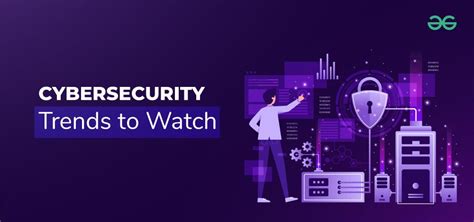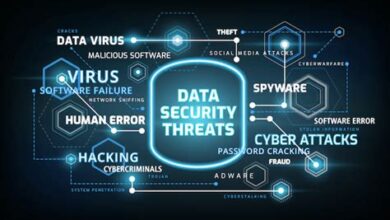The Future of Cybersecurity: Trends to Watch in 2025

Gazing into the future of cybersecurity reveals a rapidly evolving threat landscape. By 2025, expect AI and machine learning to revolutionize defenses, offering proactive threat detection and automated responses. Quantum computing presents both opportunities and significant risks, potentially breaking current encryption methods while also enabling enhanced security protocols. To fortify your cybersecurity posture, prioritize proactive threat intelligence, invest in AI-powered security solutions, and prepare for the quantum computing era by exploring quantum-resistant cryptography. Staying informed and adaptable is crucial in navigating the complexities of the future cybersecurity landscape.Here is the content section for your article, The Future of Cybersecurity: Trends to Watch in 2025:
Understanding The Evolving Threat Landscape In Cybersecurity
The cybersecurity landscape is in constant flux, transforming at an unprecedented pace due to technological advancements and the increasing sophistication of cybercriminals. Understanding these evolving threats is crucial for organizations aiming to protect their valuable data and maintain operational integrity. By staying informed about the latest attack vectors and vulnerabilities, businesses can proactively adapt their security measures and minimize potential risks. The ability to anticipate and counteract emerging threats is the cornerstone of a robust cybersecurity strategy in the future.
To effectively navigate this complex environment, it’s essential to recognize the key elements that shape the modern threat landscape. Factors such as the rise of IoT devices, the increasing reliance on cloud computing, and the proliferation of sophisticated malware all contribute to the expanding attack surface. Furthermore, geopolitical tensions and the growing involvement of nation-state actors in cyber warfare add another layer of complexity to the threat environment. Organizations must adopt a holistic approach to security, addressing not only technical vulnerabilities but also the human element and potential insider threats.
- Key Elements of the Evolving Threat Landscape
- Ransomware-as-a-Service (RaaS)
- Increased targeting of IoT devices
- Sophisticated phishing attacks leveraging AI
- Exploitation of cloud vulnerabilities
- Supply chain attacks
- Deepfake-enabled social engineering
The increasing sophistication of cyberattacks demands a corresponding evolution in cybersecurity defenses. Traditional security measures, such as firewalls and antivirus software, are no longer sufficient to protect against advanced persistent threats (APTs) and zero-day exploits. Organizations must embrace proactive threat hunting, advanced analytics, and artificial intelligence to detect and respond to threats in real-time. Furthermore, collaboration and information sharing among industry peers and government agencies are essential for staying ahead of emerging threats and mitigating their impact.
In the years to come, the threat landscape will continue to evolve, driven by new technologies and the ever-changing tactics of cybercriminals. Organizations that prioritize cybersecurity and invest in proactive security measures will be best positioned to defend against emerging threats and protect their critical assets. The integration of advanced technologies, such as AI and machine learning, into cybersecurity defenses will be crucial for automating threat detection, improving incident response, and ultimately, securing the future of our digital world.
AI And Machine Learning: Transforming Cybersecurity Defenses
Artificial Intelligence (AI) and Machine Learning (ML) are revolutionizing the cybersecurity landscape, offering sophisticated tools to combat increasingly complex threats. These technologies enable faster and more accurate threat detection, automated incident response, and predictive security analytics, significantly enhancing an organization’s defense capabilities. Embracing AI and ML is becoming crucial for staying ahead in the ongoing battle against cyber adversaries. The Future of cybersecurity heavily relies on these advancements to safeguard digital assets and infrastructure.
AI and ML algorithms can analyze vast amounts of data in real-time, identifying patterns and anomalies that would be impossible for human analysts to detect manually. This capability is particularly valuable in detecting zero-day exploits and advanced persistent threats (APTs), which often evade traditional security measures. By continuously learning from new data, AI and ML systems improve their accuracy and effectiveness over time, providing a dynamic defense against evolving cyber threats.
| Application Area | Description | Benefits |
|---|---|---|
| Threat Detection | Identifying malicious activities and anomalies in network traffic and system behavior. | Faster detection, reduced false positives, improved accuracy. |
| Incident Response | Automating the process of responding to security incidents, such as malware infections and data breaches. | Faster response times, reduced impact of incidents, efficient resource allocation. |
| Vulnerability Management | Identifying and prioritizing vulnerabilities in software and systems. | Proactive risk mitigation, reduced attack surface, improved compliance. |
| Security Analytics | Analyzing security data to gain insights into threat trends and improve security posture. | Better understanding of threats, improved decision-making, enhanced security strategy. |
The integration of AI and ML into cybersecurity is not without its challenges. Organizations need to invest in the right infrastructure, expertise, and training to effectively implement and manage these technologies. Additionally, it’s essential to address ethical considerations and ensure that AI-powered security systems are used responsibly and transparently. Despite these challenges, the benefits of AI and ML in cybersecurity are undeniable, making them essential components of a robust security strategy.
AI-Powered Threat Detection
AI-powered threat detection systems leverage machine learning algorithms to analyze network traffic, system logs, and user behavior to identify potential threats. These systems can detect anomalies that might indicate a cyberattack, such as unusual login patterns, suspicious file transfers, or malware infections. The ability to learn and adapt to new threats makes AI-powered threat detection significantly more effective than traditional signature-based security solutions.
Automated Incident Response
Automated incident response streamlines the process of responding to security incidents by automating tasks such as isolating infected systems, blocking malicious traffic, and patching vulnerabilities. AI can analyze the scope and severity of an incident, determine the appropriate response actions, and execute those actions automatically. This reduces response times and minimizes the impact of cyberattacks.
Predictive Security Analytics
Predictive security analytics uses AI and ML to analyze historical security data and identify patterns that can predict future threats. This allows organizations to proactively address vulnerabilities and strengthen their defenses before an attack occurs. By leveraging predictive analytics, security teams can anticipate and prevent cyberattacks, reducing the risk of data breaches and other security incidents.
Ultimately, the successful adoption of AI and ML in cybersecurity requires a strategic approach that aligns with an organization’s specific needs and risk profile. By carefully evaluating the available solutions and investing in the necessary expertise, organizations can harness the power of AI and ML to enhance their cybersecurity defenses and protect against evolving cyber threats.
- Enhanced Threat Detection: Quickly identify and neutralize threats with AI-driven anomaly detection.
- Automated Response: Reduce response times to incidents by automating key processes.
- Predictive Capabilities: Anticipate future attacks by analyzing trends and patterns in security data.
- Improved Efficiency: Free up human analysts to focus on more complex tasks.
- Scalability: Handle vast amounts of data and adapt to growing security needs.
The Future Of Cybersecurity: Quantum Computing Implications
Quantum computing is poised to revolutionize numerous fields, and cybersecurity is no exception. While still in its early stages, the potential of quantum computers to break current encryption algorithms poses a significant threat to data security. The development of quantum-resistant cryptography is now a critical area of focus for cybersecurity professionals. We must understand that the current cryptographic systems that protect our sensitive data could become obsolete, leaving systems vulnerable to attacks. This section explores the implications of quantum computing on cybersecurity and outlines steps to mitigate these risks.
| Aspect | Current State | Future Impact |
|---|---|---|
| Encryption | RSA, AES | Vulnerable to quantum attacks |
| Data Security | Protected by current encryption | At risk of decryption by quantum computers |
| Mitigation | Classical cryptographic methods | Quantum-resistant algorithms (Post-Quantum Cryptography) |
| Key Exchange | Diffie-Hellman, ECC | Insecure against quantum attacks |
The race to develop post-quantum cryptography (PQC) is underway, with researchers and organizations worldwide working on new algorithms that are resistant to attacks from both classical and quantum computers. The National Institute of Standards and Technology (NIST) is leading efforts to standardize these new cryptographic methods. The transition to PQC is not just a simple upgrade; it requires a complete overhaul of existing cryptographic infrastructure. It’s a complex and lengthy process that necessitates careful planning and execution. Consider this quote:
The urgency to prepare for quantum computing threats cannot be overstated. Organizations must begin assessing their cryptographic dependencies and developing migration strategies to quantum-resistant solutions.
Preparing for the quantum computing era requires a proactive approach. Organizations need to identify and prioritize their most critical data and systems for protection. This includes assessing the risk associated with current cryptographic methods and evaluating potential PQC solutions. The transition to quantum-resistant cryptography will be a multi-year effort, requiring significant investment in research, development, and deployment. To effectively safeguard digital assets against quantum threats, consider the following essential steps:
- Inventory Cryptographic Assets: Identify all systems and data using current encryption methods.
- Assess Quantum Risk: Evaluate the vulnerability of these systems to quantum attacks.
- Monitor PQC Standards: Stay informed about the latest developments in post-quantum cryptography.
- Pilot PQC Solutions: Begin testing and implementing quantum-resistant algorithms in non-critical systems.
- Develop Migration Strategies: Plan for a phased transition to PQC across the organization.
- Train Cybersecurity Teams: Equip staff with the knowledge and skills to manage PQC systems.
In conclusion, the advent of quantum computing presents both a challenge and an opportunity for the cybersecurity field. By understanding the risks and taking proactive steps to implement quantum-resistant solutions, organizations can ensure the long-term security of their data and systems. The time to act is now. Ignoring this threat could have catastrophic consequences for data security and privacy in the coming years.
Actionable Strategies For Strengthening Your Cybersecurity Posture
As we look towards the future, enhancing your cybersecurity posture requires a proactive and multi-faceted approach. It’s not enough to simply react to threats as they emerge; organizations must implement robust strategies that anticipate and mitigate potential risks. This includes not only technological solutions but also comprehensive training and policy frameworks to ensure a strong security culture.
One crucial aspect of strengthening cybersecurity is regular and thorough risk assessments. These assessments should identify vulnerabilities across all systems and processes, allowing for the prioritization of security enhancements. Understanding where your weaknesses lie is the first step in building a more resilient defense against evolving cyber threats. Consider the following table illustrating potential risk areas and their impact levels:
| Risk Area | Description | Impact Level |
|---|---|---|
| Data Breaches | Unauthorized access or disclosure of sensitive information. | High |
| Ransomware Attacks | Malware that encrypts data and demands payment for its release. | High |
| Phishing Scams | Deceptive emails or messages designed to steal credentials. | Medium |
| Insider Threats | Security breaches caused by employees or insiders. | Medium |
In addition to assessments, implementing a strong incident response plan is paramount. This plan should outline the steps to be taken in the event of a security breach, including containment, eradication, recovery, and post-incident activity. A well-defined incident response plan ensures that your organization can quickly and effectively minimize the damage caused by a cyberattack.
Finally, fostering a culture of cybersecurity awareness is essential. Educating employees about the latest threats and best practices can significantly reduce the risk of human error, which is often a major factor in security breaches. Here are some immediate actions to enhance security:
- Implement Multi-Factor Authentication (MFA): Adds an extra layer of security to user accounts.
- Regularly Update Software: Patches security vulnerabilities in operating systems and applications.
- Conduct Phishing Simulations: Trains employees to recognize and avoid phishing attempts.
- Enforce Strong Password Policies: Ensures users create and maintain secure passwords.
- Monitor Network Traffic: Detects and responds to suspicious activities in real-time.
- Data Encryption: Encrypt sensitive data both in transit and at rest.



